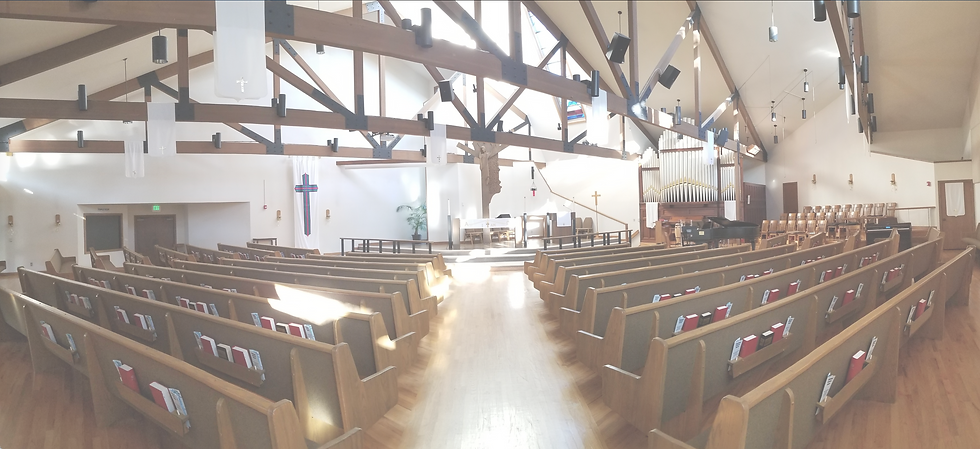The waters that carry us
- Kristen Daley Mosier, PhD

- Oct 1, 2024
- 4 min read
A reverb [sermon] for Church of the Apostles, October 1, 2023.
Readings: Ps 104:24-34; Mt 13:1-3a, 34-36a
I know that I’m home when I smell low tide. You know, that briny, hint of sewer and rotting things wafting on the air at certain times of day. Not everyone finds it endearing. But, after spending a couple years in Chicagoland for seminary, I learned that when I smell low tide, it means I’m home.

I spent much of my childhood years balancing on driftwood logs at Fay Bainbridge state park, turning over rocks on the beach north of Three Tree Point, gliding in a boat above fields of eel grass. While I did not know the name Salish Sea until recently, the sea itself has long been my neighbor, a familiar (almost familial) body that carries us from day to day.
The gospel passages today bookend parables of the kingdom of heaven in Matthew–the tales Jesus tells of God’s reign described in mustard seeds, sowers, and soils. At this point in his ministry he has already traversed the countryside teaching and healing and irking the religious authorities. Now, at this particular moment, he reveals what the reign of God is like to the crowds on the shore while he speaks from a boat on the water.
Jesus, the Word, on the water, ‘uttering things that have been hidden since the creation.’
I love this image of Jesus on the water because it hearkens back to the beginning, when the breath of God moved over the deep. When the divine brought forth the cosmos by Spirit moving, hovering, streaming across water–dividing the waters above from the waters below; forming and reforming earth elements, from the void.
Water often accompanies divine actions and events.
Other stories of Jesus on the water tend to make a point about who Jesus is in very clear terms: he calms the chaos of choppy seas, he walks upon it as one who masters creation. But here, the water simply carries him as he teaches, and carries his words to the people. This in-between set of texts help us to picture where he is as he’s revealing that which the cosmos has known from the beginning: about seeds and soils, a sower and an enemy.
What we can learn from the spaces between the teachings is that Jesus spends quite a bit of time outside of villages and towns. We find him on hillsides, near bodies of water, and crossing over bodies of water. He is (as we are) fully enmeshed in his environment.
In recent years, as I’ve paid more attention to the world of the gospel text, and to my own environment, I started to ask the question, how does creation participate in our worship, in our teaching, and in our own realm of faith? In particular, how does water participate?
This question of how water participates is the driving question behind my research and writing on baptism understood through a watershed perspective. The work of Ched Myers and Elaine Enns have helped spur on this inquiry, along with a growing sense of connection to place and desire to make faith permeable to the more-than-human world.
I’ve found some surprising compatriots when it comes to apprehending water’s significance as a participant in divine work.
For example, the earliest treatise on baptism that we know of is from Tertullian, a second century theologian in the North African city of Carthage, located on the Mediterranean Sea. He says this in relating creation with Jesus’ baptism, “the Spirit of God, who since the beginning was borne upon the waters, would as baptizer abide upon the waters. A holy thing was in fact carried upon a holy thing.”
Now carry that forward: In the mundane act of Jesus teaching about God’s rule and reign in the form of mustard seeds and mixed harvests, a holy thing was in fact carried upon a holy thing as he sat in the boat with his disciples.
How does water participate in our gatherings? We have the font, for remembering our baptism. And we have lyrics and allusions to water in our texts. But how might we intentionally bring water into our midst? Furthermore, are there ways to connect the waters of scripture to our own watersheds?
Identifying the water’s source for baptismal waters, and naming local waters are ways that communities of faith are beginning to weave together the sacramental with material realities. These weeks when you all have paused to reflect upon the waters in word and worship are vital opportunities for deepening connections with the surrounding watershed.
As our senses become more attuned to the elements of creation in our midst here in worship, we discover that the world around us begins to speak of divine holiness. I invite you to listen closely the next time you go down to the water, or cross the sea on a ferry (even when traveling over one of our floating bridges). How does the water feel that day? What do the ripples and waves communicate? What colors are reflected in the surface of the water?
Here in Seattle we are surrounded by bodies of water, saltwater and fresh, that carry us to our destinations as they have done for millennia. And they carry us in other ways.
Not everyone feels connected to the environment in the same way, yet this is what the gift of baptism offers. The splash of the water from the baptismal font is a reminder of our amniotic beginning and of a divine invitation to pass through the waters of rebirth to be united with God and the rest of creation.
So, as the sea carried Jesus--a holy thing upon a holy thing--may each of us be reminded as we gaze upon our waters that we too are carried by water and Spirit into new life.


Comments